 |
|

|
 |
TABLE of CONTENTS
|
Workers from Roseau, Baudette help tornado-stricken Warroad |
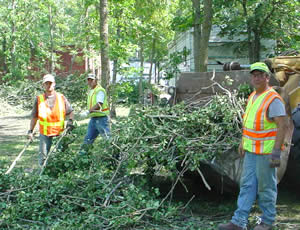
At right, Ron Thramer , Roseau truck station, helps a couple of Warroad city employees clear debris left in the wake of an F-3 tornado that roared through Warroad Aug. 5. Photo by Curt Larson |
By Craig Wilkins
A powerful F-3 tornado, unusual for the region, struck Warroad Aug. 5, causing extensive damage.
The tornado, with wind speeds nearing 200 miles an hour, hit the city at 7 p.m. Shortly after 8 p.m., Curt Larson and Bob Ruud from the Bemidji District’s Roseau truck station responded.
They brought barricades and other traffic control devices to help local authorities close roads and direct traffic in the storm’s aftermath.
On Aug. 7, four workers from the Baudette and Roseau truck stations started using their trucks and loaders to clear fallen trees and other debris, said Larson, sub-area supervisor at Roseau.
The Warroad crew includes Ron Thramer and Paul Thompson, Roseau, and Ken Larson and Bill Fischer, Baudette.
Curt Larson said he expects the crew to stay in Warroad until Aug. 10 to support the clean-up effort being conducted by area agencies and volunteers.
“We’ve got traffic almost back to normal,” he said, crediting area law enforcement agencies, fire departments, a radio station and amateur radio operators with providing enough notice to get people out of harm’s way.
“It’s amazing that there were no deaths or even serious injuries,” Larson said.
|
 |
|

|
 |
TABLE of CONTENTS
 |
Lightning strikes twice: fractures pavement near Red Wing, damages District 4 headquarters |
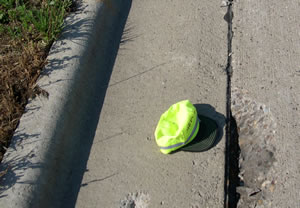
Tom Meath, District 6 materials engineer, uses his hat to highlight the size of pieces of concrete pavement blown out of Hwy 58 in Red Wing during a thunderstorm. Photo by Chris Dulian |
By Craig Wilkins
Severe weather conditions regularly pummel Minnesota highways: floods, frost heaves, 100-plus degree temperatures and so on.
It’s time to add a new one—lightning, which struck Hwy 58 in District 6 on July 19 and the District 4 headquarters in Detroit Lakes less than a week later.
A bolt of lightning hit Hwy 58’s southbound lanes in Red Wing, blowing out several pieces of pavement near the shoulder about six inches wide, three inches deep and a foot long.
The insides of the blown-out areas show scorch marks, a sign they were caused by lightning, said Tom Meath, district materials engineer.
Meath believes the lightning may have bounced up and down along the highway by following keyways—steel-reinforced structures that tie curb and gutter installations to the main roadway’s concrete panels.
Whatever the cause, the explosion sent pieces of concrete pavement flying as far as 150 feet away.
When Tim Zierden, Red Wing sub-area supervisor, first saw the damage, he thought it was heat-related or a pavement failure in the recently rebuilt highway.
But a nearby property owner told Zierden the damage occurred during a thunderstorm he witnessed.
“It’s pretty amazing,” Zierden said.
Detroit Lakes headquarters takes a hit, too
Lightning hit close to home for people in District 4 July 24 as well. A strike in the parking lot at district headquarters in Detroit Lakes caused scattered but costly damage.
Inside, the charge from the lightning bolt knocked out the computer of District Engineer Lee Berget, plus a few others, and partly disabled the phone system. Receptionist Darlene Hynding had to page employees all day because she was unable to transfer phone calls.
Outside, the lightning honed in on Maintenance Superintendent Dennis Redig’s new pick-up, damaging its electronic systems and disabling the truck. Technicians are repairing the pickup as they determine which parts of its electronic equipment need replacement.
The bolt from the blue also left a more permanent mark—a pothole-like depression where a divot of asphalt pavement was blown away.
|
 |
|

|
 |
TABLE of CONTENTS
 |
Districts 'experience' all kinds of disasters in emergency management exercises |
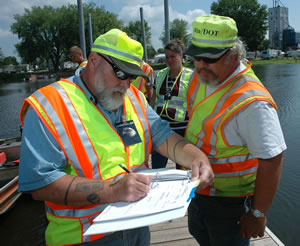
At left, Larry Cooper, District 7 bridge maintenance supervisor, was a controller at the Rochester District Homeland Security and Emergency Management exercise July 26. With him is Larry Waletzki, District 6 bridge maintenance supervisor. Photo by David Gonzalez |
By Kevin Gutknecht
This is a drill.
A simple enough phrase, but to a number of district staff around the state, it has taken on new meaning this year, thanks to the district exercises run by Mn/DOT’s Homeland Security and Emergency Management office.
The exercises are generally three-day events. The first day is training for exercise staff, the second day is the actual exercise. The final day is an after-action review in which exercise staff talk about what occurred and what can be improved.
It is the second day, however, that tends to be most memorable for the district employees. The exercise is built around a fictional scenario that has a number of large and small disasters occurring on the transportation infrastructure. Some of the events are unusual, and some are typical. They have included such situations as a truck carrying hazardous material tipping over, a mysterious caller warning of a hidden bomb, Mn/DOT vehicles stolen from maintenance facilities, and key staff involved in car crashes and are not available.
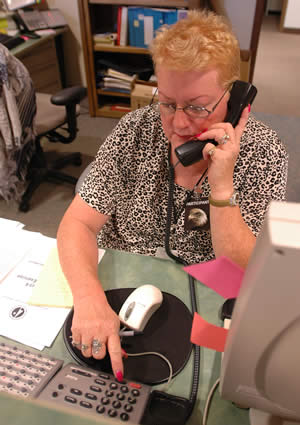
Marlene Horsman, District 6 receptionist, fields incoming phone calls from the public and the news media during the HSEM exercise. Photo by David Gonzalez |
“The purpose of the exercises is to test Mn/DOT policies and procedures for emergency situations,” said Sonia Morphew, Homeland Security and Emergency Management director. “And it tests how the district staff responds when faced with these types of emergencies.”
Each district scenario is built specifically for that district, Morphew added, so the scenario in District 1 will be much different than the situation that occurred in District 6.
The exercise is run by a consultant group that has trained many other organizations around the country in emergency management. The exercise is functional, which means the district staff responds to scenario “injects” by managing the process without actually putting Mn/DOT people on the street.
For example, if a hazardous waste spill blocked a roadway, the district staff calls the maintenance office and directs that barriers be placed. The traffic engineer plans a detour and the public affairs coordinator develops a news release to send out detailing the occurrence. However, the district does not actually execute the plan.
“The exercise gives the districts the chance to evaluate existing memorandums of understanding, memorandums of agreement, coordination with outside agencies, response activities and internal policies and procedures,” Morphew said.
“The exercises help district staff better understand how they might really operate in emergency situations because things happen quickly and unexpectedly. The staff learns how they operate under pressure.”
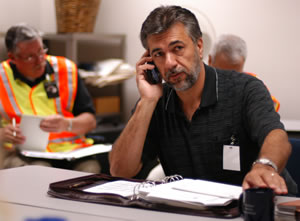
Jeff Vlaminck, Rochester/District 6 assistant district engineer, led the district's efforts during the HSEM exercise. Photo by David Gonzalez |
Rochester staff participate in exercise
District 6 took part in its HSEM exercise July 26. The scenario involved bombs, overturned trucks and, because of its proximity to the Mississippi River, a bridge with structural problems. There were also a large number of calls to the front desk from the “public” and “news media.”
Jeff Vlaminck, assistant District 6 engineer, was the incident commander for the exercise.
“It was, for the most part, what I thought it would be,” he said. “It was a good learning experience for all of the players involved.”
Based on the after action report they will receive, he said that the district may adjust its emergency operations plan.
“We could do a better job of documenting our standard operating procedures. And, I would bring in support for logging the events much sooner,” he said.
Kristine Hernandez, District 6 public affairs coordinator, said the exercise was beneficial.
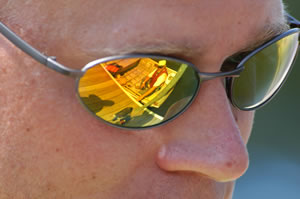
One of the District 6 participants in a boat can be seen reflected in the sunglasses of this unidentified controller at the HSEM exercise. Photo by David Gonzalez |
“Events were greatly elevated, timelines were crunched and the temperature rose,” she said. “We need to know how to work through our roles before disaster happens so we can hit the ground running when it does.”
Hernandez added that she learned that she needs to start delegating some tasks to others so she could have more time to think, plan and then react.
Rhonda Prestegard is one to whom Hernandez delegated some work.
“The exercise was beneficial. It made me realize how ‘out of sync’ we could be in a serious situation,” Prestegard said. “The Emergency Operations Center needs to be better organized and controlled. We could section off some areas to allow quiet space for phone calls and detailed discussions.”
By the end of 2006, all Mn/DOT Districts will have gone through an exercise, Morphew said. District 2 and District 4 will participate in mid-August, District 1 in September and Metro District in October. The HSEM office tentatively plans to hold an exercise next year that will involve all of Mn/DOT to some degree.
|
 |
|

|
 |
TABLE of CONTENTS
 |
Government Affairs seeks proposals for 2007 legislative session |
By Kay Korsgaard
It may seem like the 2006 legislative session just ended, but it is already time to start preparing for the 2007 session.
Each year Mn/DOT brings forward proposals to the Legislature—laws that need to be changed or repealed or new legislation that would help Mn/DOT better do its work.
Any Mn/DOT employee can suggest ideas for Mn/DOT’s proposal. However, there is a process to follow to ensure that all proposed items meet Mn/DOT’s overall objectives, said Betsy Parker, Government Affairs director.
That process begins with employees talking to their office director. Office directors will then submit proposals to division directors who review all suggestions from their division, and sign off on them before submitting them collectively to the Office of Government Affairs.
Commissioner’s staff then reviews all approved proposals and in turn, submits Mn/DOT’s proposal to the governor’s office.
Proposals must include fiscal information (a rough estimate of potential costs/savings for the agency) and information about supporters and opponents.
The deadline to submit completed proposal forms to your division director is Aug. 30.
|
 |
|

|
 |
TABLE of CONTENTS
 |
Valley Creek Road/I-494 interchange re-opens |
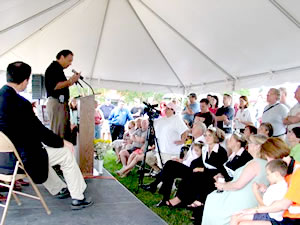
Khani Sahebjam, Metro District engineer, speaks during the ceremonies celebrating the re-opening of the Valley Creek Road interchange at Interstate 494. U.S. Rep. Mark Kennedy, also one of the event speakers, is seated in the foreground. Photo by Kevin Walker
|
Three classic cars led the parade of vehicles Aug. 5 on the re-opened Valley Creek Road interchange at Interstate 494 to help celebrate the completion of the reconstruction project in the east Twin Cities metro area.
Speakers at the event included Khani Sahebjam, Metro District engineer; Don Theisen, Washington County engineer; Dick Stafford, Washington County commissioner; Bill Hargis, mayor of Woodbury, Joe Kielbasa, Woodbury Chamber of Commerce, and U.S. Rep. Mark Kennedy.
Some finishing work on the interchange still needs to be done, which will require temporary lane restrictions, according to Mary McFarland-Brooks, Metro District public affairs coordinator. However, that the interchange will remain open while the work is being completed, she said.
Click here for more information about the I-494 project. |
 |
|

|
 |
TABLE of CONTENTS
 |
National conference will examine transportation industry’s civil rights challenges |

Mn/DOT will host a national conference on transportation and civil rights Aug. 18-23 in Minneapolis.Graphic by Paula Gustafson |
Mn/DOT will host a national conference on transportation and civil rights Aug. 18-23 in Minneapolis. The conference will explore expanding the roles of women and people of color for employment and business opportunities in the transportation industry.
“The Power of Civil Rights: Challenging Transportation” will be held in downtown Minneapolis. The American Association of State Highway and Transportation Officials is sponsoring the event.
The conference will include workshops that address issues such as complying with civil rights laws and Affirmative Action goals when awarding contracts, offering job training opportunities and recruiting women and minority group members for employment in the field.
While directed at public agency civil rights staff, contractors and consultants, the conference offers benefits to a much wider audience, according to Lynnette Geschwind, director of Mn/DOT’s Office of Affirmative Action.
“This conference focuses on inclusion,” she said, “from equitable opportunities for women and people of color to helping create workplaces where diverse people and ideas are valued and respected.”
AASHTO conducts the conference every two years to support DOTs’ and other public agencies’ ability to reach their goals and their public obligation to distribute contract awards equitably.
Additional information about the conference is available from its Web site: http://www.dot.state.mn.us/aashto.
|
 |
|

|
 |
TABLE of CONTENTS
 |
Motorcycle crash claims life of St. Cloud’s Jim Hudec |
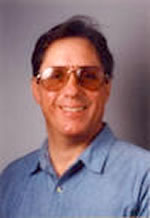
Jim Hudec, who was a senior transportation generalist with District 3, died July 28 following a traffic crash involving his motorcycle. He was 61. Photo courtesy of District 3 |
Jim Hudec, who was a senior transportation generalist with District 3, died July 28 following a traffic crash involving his motorcycle.
The crash occurred in St. Francis, near his home in Princeton.
He was 61. Funeral services were held Aug. 4.
Hudec was assigned to the district construction office in St. Cloud; he joined Mn/DOT in 1990. His work at St. Cloud centered on bridge construction.
Before joining the department, Hudec was employed as a trainer for a photo processing firm and as a long-distance trucker.
Hudec was an enthusiastic motorcyclist who enjoyed working on and riding his machines.
Rick Beckes, a project supervisor and Hudec’s supervisor, said he was a good-humored worker who took his job seriously.
“He was the kind of guy you could count on to do whatever was needed to get the job done,” Beckes said. “He will be missed.”
Hudec’s survivors include his spouse, Danielle Hudec, mother, sister and three sons: Dennis Aleckson, Mike Hudec and Jesse Hudec. Jesse Hudec is a transportation generalist assigned to District 3’s Cambridge truck station.
|
 |
|

|
 |
TABLE of CONTENTS
 |
Interstate 94 becomes integral part of Twin Cities’ growth, dynamism |
|
By Craig Wilkins
Construction of Interstate 94 that slices diagonally just east of Moorhead to Hudson, Wis. and beyond rearranged the state’s landscape, including that of the Twin Cities metro area.
Sections of the freeway were completed in a patchwork manner as funds, right of way and people became available.
Such was also the case in the Twin Cities metro area. Completion stretched over two decades. The first section that actually linked Minneapolis and St. Paul was finished in 1968.
However, the final section of I-94 east of St. Paul to the St. Croix River wasn’t completed until 1987.
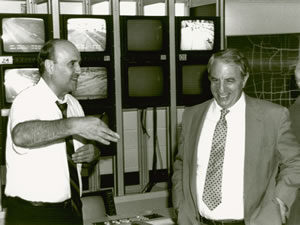
Glenn Carlson, now retired, explained the workings of the Traffic Management Center to an official from the Ford Motor Co. The TMC was created to better manage traffic on the Twin Cities metro area’s freeway system. Formerly located in downtown Minneapolis , the facility is now part of the Regional Transportation Management Center located in Roseville. Mn/DOT file photo |
In a sense, the freeway has never been totally finished. The roadway has been realigned, widened and extended, including the 10-mile section of I-394 between Minneapolis and Minnetonka.
Several bridges over the freeway were replaced when spiraling traffic rates required adding new lanes or making other changes.
Projects are now under way to increase the system’s capacity, including adding lanes to a section of I-494 and rebuilding the I-694/I-35E interchange, the “Unweave the Weave” project, to eliminate one of the region’s most severe traffic bottlenecks.
Continuing work on I-94 and its branches reflects the region’s dynamism that the freeway helped create and continues to fuel.
To read more about these projects and the people who built them, visit Mn/DOT’s 50th anniversary of the interstate highway system Web site: http://www.dot.state.mn.us/interstate50/.
|
 |
|

|
 |
TABLE of CONTENTS
 |
Transit drivers compete, learn during statewide bus roadeo |
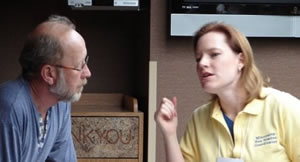
Jim Anderson and Lynn Frank, Office of Transit, were part of the team overseeing the 2006 Minnesota Bus Roadeo July 29 in Duluth. Photo by Mitchell Brod |
By Craig Wilkins
Bus drivers from 27 transit services challenged each other and themselves on a roadeo course to learn new skills during the 2006 Minnesota Bus Roadeo.
The event was held July 29 in Duluth.
Participants in the roadeo nudged their buses through the roadeo course that simulates the challenges they face during their everyday driving experiences.
Drivers from St. Cloud’s Metro Bus transit service took three of the top six individual scores. Metro Bus drivers placed first in the large and small bus categories and second in the large bus category.
Other top scorers represented Grant County Alpha Transit, Elbow Lake; Tri-Valley Heartland Express, Crookston, and Minneapolis-based Laidlaw Transit Services.
Drivers received training on ways to manage disruptions such as route changes, unruly passengers and radio calls from dispatchers.
Mn/DOT and the Rural Transit Assistance Program sponsored the event. The Duluth Transit Authority served as the host agency.
“Events such as the bus roadeo enable drivers to sharpen their skills and receive specialized training that improves their ability to provide safe and effective service to transit users statewide,” said Donna Allan, Office of Transit director.
More information about the roadeo and transit programs may be found at www.dot.state.mn.us/transit/.
|
 |
|

|
 |
TABLE of CONTENTS
 |
Moving back to CO has some trade-offs, but benefits, too |
Kelly Kennedy, transportation program specialist 2, has worked for Mn/DOT for 13 years, more than half of them with the Office of Aeronautics. At the end of May, her current work group, the Office of Freight and Commercial Vehicle Operations, moved from the Administrative Truck Center in Mendota Heights to the Central Office building in St. Paul. We asked her to share her reactions to the relocation.

Kelly Kennedy, Office of Freight and Commercial Vehicle Operations, returned to the Central Office in May after 10 years of working in other Mn/DOT locations. Photo by David Gonzalez |
It has been 10 years since I last worked at Central Office (in the Office of Maintenance). When I found out that my current work group, the Office of Freight and Commercial Vehicle Operations, was to be relocated to CO, I had no trepidations. I knew I would be able to reconnect with people whom I had worked with 10 years ago. And since I had worked here before, I didn’t feel anxious at all.
Upon learning that we were moving back, I got to thinking about my previous time here at CO. I always liked being in the main building. I feel that you are much more connected to the department. You have many more opportunities to take advantage of the different programs and classes offered. And one of my favorite things to do is walking the tunnels, especially in the winter. There are always people to chat with and find out how things in the department are going.
By working in the main building, you get a sense that you are actually a part of it. It doesn’t seem as though the “CO” is this distant mystical place. But for those who have never worked here before, it can be intimidating. I mean you have the “Fourth Floor” where Commissioner Molnau and her staff reside. Just think, you might actually run into the commissioner sometime in the elevator or in a hallway. Do you turn to her in the elevator and say “hi” and introduce yourself? What is the appropriate behavior? I myself would smile, say “hi” and ask her how things are going!
A down side to the move is that we do have to pay for parking now. Yes, we were spoiled at the old truck station in Mendota Heights, with free parking and being able to park right outside the building. It could be worse.
Mn/DOT has a wonderful cafeteria with a variety of foods that can please just about any palate. There is a workout room with a locker room too, and for those who know me, they know what this means to me! And lastly, I look forward to being able to walk around the beautiful mall area, especially on those cool fall days. Overall, I would say that moving back is just fine by me.
|
 |
|

|
 |
TABLE of CONTENTS
 |
Open Houses are more than a place for free cookies |
Qin Tang is the technical services librarian in the Mn/DOT Library. She started working for the department in May 2000.

Qin Tang, Mn/DOT Library, believes that open houses give employees an opportunity to build a sense of community and get a big picture of the whole organization. Photo by David Gonzalez |
As a Mn/DOT employee for more than six years, I have to admit there are still many offices and operations within Mn/DOT that I know little about.
But for someone like me who works in the library and whose job is to help employees and the general public find information, it is important to know this organization and what each office does. I find open houses provide a good opportunity for me to meet people from other offices and find out what they do, which in turn helps me do a better job.
The Office of Freight and Commercial Vehicle Operations’ open house on Aug. 1 provides a good example of what I mean.
By walking around the office, talking to people and asking questions, I learned a lot. To my shame, however, I also realized that I had made a mistake. Not too long ago, a woman came to the library wanting to start her own company providing transportation services for individuals to hospitals. I showed her where to find information about starting a small business, registering the company, etc., and I referred her to the Department of Public Safety for licensing and permit questions.
At the open house, I realized what I told the woman was wrong; I should have referred her to the OFCVO instead of Public Safety for a special transportation services permit.
Now I know better.
I think we should hold open houses not only for special occasions, but on a regular basis, too. Our jobs are so compartmentalized and specialized that we often don't know what the person sitting next to us does. Open houses give people the opportunity to meet others, learn about other offices, build connections and a sense of community, and get a big picture of the whole organization. As a result, we can all do a better job. People are more likely to provide better services and help in a timely manner to those they already know by name or face.
Providing cookies at the open house will probably get more people in the door, but it's not a requirement. People will come if they are truly interested. I like to go to open houses and ask lots of questions. I might even ask some stupid questions, but so what? As long as I learn something new, I feel good.
|
 |
|
| |
|



